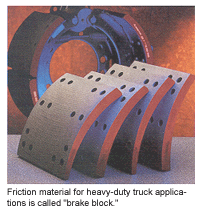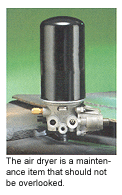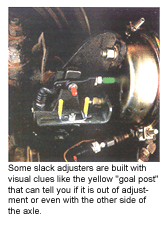Big trucks have big brakes that equal big repair opportunities for shops that can handle this kind of work. If you get a job where you’ll be servicing big trucks – say a commercial fleet account – truck brake repairs require some education and know-how if you’ve never done this kind of work before.
As you may know, passenger car and light-truck brakes are all hydraulic, and typically have disc brakes up front and drums in the rear (except on four-wheel disc brake applications). With big trucks, air-actuated brakes are used rather than hydraulic brakes. And on the big rigs, any loss of air pressure in the system causes the brakes to apply. Federal Motor Vehicle Safety Standard (FMVSS) 121 requires this kind of safety backup to prevent runaway trucks from careening down the highway.
One major difference you’ll find between doing a brake job on a heavy-duty truck and a passenger car is the selection of replacement brake linings. Heavy-duty (HD) brakes are sold to fit a particular type of axle application, not a truck or trailer. And, shoes are sold on an exchange basis rather than outright. So, if the old shoes are damaged, you may not receive full exchange credit. Defects to look for include torch damage around anchor holes, bent, damaged or cracked ears around anchor holes or cams, enlarged or worn anchor holes, bent or worn shoe table, elongated rivet holes in shoe table, or broken welds.
Get the Correct Info
To determine a HD shoe application, you first have to tell your parts supplier the type of axle (drive axle, steering axle or trailer axle) as well as the axle manufacturer (Dana, Eaton, Fruehauf, Rockwell, Timken, etc.). Then you need the size of the brake shoes (diameter & width), and the type of shoes (standard with a full round eye on anchor end, “Q” type with open eye on both anchor and cam ends, or wedge type).
On some applications, you may also have to determine who manufactured the shoes. Rockwell “P” and Fruehauf 16-1/2 inch shoes are very similar in appearance, as are Rockwell “Q” and Fruehauf “XEM” 16-1/2 inch shoes. To distinguish one type of shoe from another, you may have to use a stretch gauge and anchor pin gauge (special tools which can be purchased from your brake supplier).
Once you’ve identified the axle and shoes, the next step is to choose the best grade of replacement friction block for the application. This will depend on how the truck or trailer is used.
Replacement Intervals
 A big difference you’ll find between HD friction linings and those that are used in smaller vehicles is the frequency of replacement. Passenger car linings may need to be replaced once every couple of years or 30,000 to 40,000 miles. Heavy-duty trucks, on the other hand, may need a set of linings up to four times a year or every 60,000 to 70,000 miles depending on the type of driving.
A big difference you’ll find between HD friction linings and those that are used in smaller vehicles is the frequency of replacement. Passenger car linings may need to be replaced once every couple of years or 30,000 to 40,000 miles. Heavy-duty trucks, on the other hand, may need a set of linings up to four times a year or every 60,000 to 70,000 miles depending on the type of driving.
Replacement linings for heavy-duty trucks come in various formulations of nonasbestos organic (NAO) and semi-metallic. The semi-metallic blends are for higher temperatures and loads. As a general rule, always replace same with same or a higher grade of friction material.
One thing to look for when you inspect the linings is heat checking. If the linings are full of cracks, it would tell you the brakes have been running very hot. This may be the result of uneven brake loads, brake drag, or the use of linings that don’t have a high enough temperature rating for the application.
For heavy loads and heavy-use applications, use a premium grade semi-metallic lining. These contain a high percentage of steel wool fibers for high temperature fade-resistance (up to 1,000 degrees F), and graphite for extended life and noise reduction. Typical application for a premium brake block material include tri-axle dumps, tandem-axle refuse, tandem-axle fire trucks, car haulers or other urban vehicles that constantly stop and go or carry heavy loads on steep grades.
For heavy-service applications where noise is undesirable and stop-and-go operation is the norm, a different grade of lining would probably work better. This might include a combination of different friction materials with a metallic compound for the S-cam side of the brake and an organic material for the anchor side.
Choosing the best lining material depends on the weight of the truck, the type of truck, the operating conditions and temperatures the brakes are likely to encounter. The drive and trailer brakes on line haul trucks, double-axle trucks, dump trucks, concrete mixers, fire trucks and similar applications would likely require a higher temperature material than the front brakes on a truck that spends most of its time on the highway or hauling only light loads.
Making Replacements and Adjustments
If the old linings are worn to minimum service specifications, or are contaminated with grease or oil, they must be replaced. When linings are replaced, new brake hardware should also be installed to restore the brakes to like-new condition. This includes all shoe attaching hardware, anchor pin bushings, oil seals and cam bushings. Anchor pins, brake rollers and the bushing area of the cams should all be lubricated with high temperature brake grease. NOTE: Do not lubricate the face of the roller, only the bearing surface that contacts the brake shoe.
 Inspect S-cams for wear at the bushings, head and spline areas. Check slack adjusters for proper settings and operation. Check clevis pins and slack bushings for wear. If wear is over 0.030 in., replace both. Never mix manual and automatic slack adjusters, and never use slack adjusters from different manufacturers on the same axle.
Inspect S-cams for wear at the bushings, head and spline areas. Check slack adjusters for proper settings and operation. Check clevis pins and slack bushings for wear. If wear is over 0.030 in., replace both. Never mix manual and automatic slack adjusters, and never use slack adjusters from different manufacturers on the same axle.
Inspect all air hoses that lead to the brake chambers, and replace any hoses that are cracked or damaged.
Adjust brakes to equalize travel on both sides of an axle. The shoes should be positioned as close to the drums as possible without any drag. Manual slack adjusters should be set to .020 in. drum clearance. All brakes should be adjusted at the same time. After these adjustments have been made, make sure the brake chamber piston rod intersects the slack adjuster at 90 degrees.
If the old brakes show excessive lining or drum wear, check the compatibility of the truck and trailer brake chambers. Also, check the brake chambers to make sure they are fully releasing when the brakes are not applied.
If a brake chamber needs to be replaced, make sure you get the correct replacement part for the application. Always replace chambers in pairs, do not mix parts from different manufacturers, and do not mix long stroke chambers with standard stroke chambers.
Brake drums must also be inspected, and resurfaced or replaced depending on their condition and the amount of wear. Worn or damaged brake drums can be extremely dangerous. As a rule, drums should not be returned to service if diameter wear exceeds 0.080 in., if the drum has hard spots (blue, discolored areas) or cracks across the drum braking surface.
 Hold on, a minute – don’t forget the wheel bearings. They need to be inspected, cleaned and repacked with fresh wheel bearing grease when you reline the brakes. Axle shafts should be lightly lubricated so that the hubs will slide easily into place.
Hold on, a minute – don’t forget the wheel bearings. They need to be inspected, cleaned and repacked with fresh wheel bearing grease when you reline the brakes. Axle shafts should be lightly lubricated so that the hubs will slide easily into place.
Airing It Out
Air pressure is generated by an engine-driven compressor, which is also supplied with oil, coolant and filtered air by the engine. The compressor’s output on newer trucks (1992 models & up) is regulated by a governor. FMVSS 121 requires a cut-in pressure of at least 85 psi, but 105 psi is recommended to handle trailer brakes.
An “air dryer” takes the air from the compressor and removes most of the moisture and contaminants before the air enters the “wet tank” (a storage tank that acts as a pressure reservoir and also a secondary trap for moisture). The dryer on turbocharged engines also has an “isolation valve” to prevent loss of boost pressure if the compressor receives air under pressure from the turbo.
Mounted on the wet tank are a “pop-off valve” (a safety valve that vents air if tank pressure exceeds 150 psi), a “low pressure switch” to warn the driver of low air pressure, and an automatic or manual “drain valve” to drain moisture from the wet tank.
HD Systems Defined
The following are terms and components you’ll need to become familiar with when servicing HD brake systems.
| SECONDARY SERVICE SYSTEM: This part of the air brake system controls the brakes on the front steering axle of the tractor. It includes a “dry” tank for air storage (with a one-way check valve and pressure gauge), a “dual foot control valve” that allows the driver to modulate the application of the vehicle’s brakes, a “quick release valve” to release air from the service chambers in the front brakes, “service chambers” which use air pressure against a diaphragm to apply the brakes via a push rod, and slack adjusters (manual or automatic) for adjusting the brakes. |
| PRIMARY SERVICE SYSTEM: This part of the air brake system also has a separate “dry” tank (with gauge and one-way check valve) and operates through the dual foot control valve. Air is routed to the drive axle brakes via a “service relay” which modulates both application and release. The spring brakes provide both service and parking braking. Manual or automatic slack adjusters provide brake adjustment. |
| PARKING SYSTEM: A yellow diamond knob “dash valve” allows the driver to release and apply the parking brakes. A “quick release valve” on 1992 and newer trucks allows the parking brakes to be fully applied in three seconds or less. The spring brakes are applied when there is no air pressure in either the parking or service chambers of the unit. When air is applied to the parking side only, the brakes are released. When air is applied to both sides, the brakes are reapplied to stop the vehicle. A “two-way check valve” monitors the pressure in the primary and secondary system and delivers whichever pressure is higher. This devise is required by FMVSS 121 so that anytime air pressure is lost in either the primary or secondary service system, the vehicle’s parking brakes can be released at least once. |
| ANTI-COMPOUNDING SYSTEM: A “quick release two-way check valve” is used to prevent the parking brakes and service brakes from being applied simultaneously. Not all vehicles have this. |
| EMERGENCY SYSTEM: An “inversion valve” is required on all straight trucks and buses, and is optional on tractor/trailers. This system comes into play if air pressure is lost in the primary service system. It gradually releases air from the spring brake parking chambers so the vehicle can come to a safe, controlled stop. |
| TRAILER SUPPLY SYSTEM: A second knob on the dash, color coded red and shaped like an octagon, controls the application and release of the trailer’s parking brakes, plus the filling of the trailer service reservoirs with air pressure. The trailer control valve may be part of a “module dash control valve” that includes the yellow parking brake knob for the tractor.
A protection valve isolates the trailer air lines from those on the tractor to prevent loss of air pressure in the tractor in case of a leak in the trailer’s system. A trailer supply “gladhand” control valve (color coded red and marked “emergency”) provides a quick coupling between the tractor and trailer, and allows air to pass from the tractor to release the trailer parking brakes. Some applications may use a “full function trailer valve” which uses one valve to both release the trailer spring brakes and fill the air reservoirs. Multi-trailer applications have a “fast air balancing” (FAB) valve to speed up the air control signal from the lead trailer to the second or third trailer. |
Maintaining the Air Brakes
Now that we’ve covered the basics of a truck air brake system, how do you maintain it? An air brake system requires a clean, dry and oil-free air supply. So a good place to start is the wet tank. The maximum amount of water in the wet tank should be two ounces or less. If you find more than two ounces, something is wrong with the air delivery system. Oil from the air compressor is probably working its way toward the wet tank. Oil contaminates the air dryer desiccant bead sack and prevents it from doing its job (absorbing water), and will damage the rubber seals in the system’s air valves. The end result can be rapid and uneven wear of the brake linings.
Rapid brake wear is an indication of improper air valve timing. Some brakes may be applying sooner than others instead of all applying simultaneously. Other factors that can upset brake timing include brake adjustment, slack adjusters, bent brake hardware and linings that are not properly matched to the drums.


